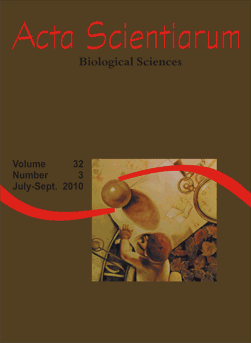<b>Evaluation of the potential of <em>Pontederia parviflora</em> Alexander in the absorption of copper (Cu) and its effects on tissues</b> - doi: 10.4025/actascibiolsci.v32i3.3940
Keywords:
aquatic macrophyte, phytoremediation, copper
Abstract
The study sought to evaluate the potential of the aquatic macrophyte Pontederia parviflora Alexander in the absorption of copper (Cu) and possible variations in its tissues after 21 days of exposure to this metal. The concentration of Cu was analyzed in the solution and in the vegetal tissues (stem, root and leaves). The experiment was set up in triplicates with weekly measurements of pH, temperature and DO. The results indicated that P. parviflora reduced 96% of Cu in the solution and the root was the vegetal tissue, which accumulated more Cu. Values of pH, DO and temperature were in accordance with the metabolic activities of the plants. In the anatomic analyses, dark spots were identified in the vascular bundles and in the epidermis of the aerial parts, highlighting the variation resulting from the presence of this substance. However, these variations were not sufficient to damage the development of the individuals. P. parviflora showed high capacity of extraction and storage of the metal, being a good alternative to aquatic environments with high concentrations of Cu.Downloads
Download data is not yet available.
Published
2010-09-14
How to Cite
Balassa, G. C., Souza, D. C. de, & Lima, S. B. de. (2010). <b>Evaluation of the potential of <em>Pontederia parviflora</em> Alexander in the absorption of copper (Cu) and its effects on tissues</b> - doi: 10.4025/actascibiolsci.v32i3.3940. Acta Scientiarum. Biological Sciences, 32(3), 311-316. https://doi.org/10.4025/actascibiolsci.v32i3.3940
Issue
Section
Vegetable Morphology & Physiology
DECLARATION OF ORIGINALITY AND COPYRIGHTS
I Declare that current article is original and has not been submitted for publication, in part or in whole, to any other national or international journal.
The copyrights belong exclusively to the authors. Published content is licensed under Creative Commons Attribution 4.0 (CC BY 4.0) guidelines, which allows sharing (copy and distribution of the material in any medium or format) and adaptation (remix, transform, and build upon the material) for any purpose, even commercially, under the terms of attribution.
Read this link for further information on how to use CC BY 4.0 properly.
0.6
2019CiteScore
31st percentile
Powered by 

0.6
2019CiteScore
31st percentile
Powered by 











1.png)




3.png)













